 Composer/keyboardist/producer Elodie Lauten creates operas, music for dance and theatre, orchestral, chamber and instrumental music. Not a household name, she is however widely recognized by historians as a leading figure of post-minimalism and a force on the new music scene, with 20 releases on a number of labels.
Composer/keyboardist/producer Elodie Lauten creates operas, music for dance and theatre, orchestral, chamber and instrumental music. Not a household name, she is however widely recognized by historians as a leading figure of post-minimalism and a force on the new music scene, with 20 releases on a number of labels.
Her opera Waking in New York, Portrait of Allen Ginsberg was presented by the New York City Opera (2004 VOX and Friends) in May 2004, after being released on 4Tay, following three well-received productions. OrfReo, a new opera for Baroque ensemble was premiered at Merkin Hall by the Queen's Chamber Band, whose New Music Alive CD (released on Capstone in 2004) includes Lauten's The Architect. The Orfreo CD was released in December 2004 on Studio 21. In September 2004 Lauten was composer-in-residence at Hope College, MI. Lauten's Symphony 2001, was premiered in February 2003 by the SEM Orchestra in New York. In 1999, Lauten's Deus ex Machina Cycle for voices and Baroque ensemble (4Tay) received strong critical acclaim in the US and Europe. Lauten's Variations On The Orange Cycle (Lovely Music, 1998) was included in Chamber Music America's list of 100 best works of the 20th century.
Born in Paris, France, she was classically trained as a pianist since age 7. She received a Master's in composition from New York University where she studied Western composition with Dinu Ghezzo and Indian classical music with Ahkmal Parwez. Daughter of jazz pianist/drummer Errol Parker, she is also a fluent improviser. She became an American citizen in 1984 and has lived in New York since the early seventies
|
|
|
|
|

Saturday, November 15, 2008
What makes me think
Lately I spend just about as much time with art as I do with music, and it is the A.I.R. Gallery History Show that gave me inspiration this time around. A.I.R. is short for Artists in Residence, an incredibly resilient women's gallery formed in the early seventies and whose current primary function is not to make a profit but rather to teach by example. A three-part "History Show" takes place this fall, inaugurating the gallery relocation to Dumbo, at 111 Front Street, Brooklyn (great neighborhood - almost feels like seventies Soho) and concurrently at the Tracey/Barry Gallery at the Bobst Library of NYU through December 12.
I visited both October and November shows at the new A.I.R. Gallery and loved the feel of so many strong personalities, with freedom from stylistic commitments, with playfulness and/or seriousness, in a rich and multifarious cultural fabric. Even if some pieces seem slightly more reflective of "women's" issues, most of the art is "unsexed" i.e. it does not point to the gender of the artists in any direct manner - which adds to my theory that there is no such thing as women's art or women's music. Art is neither female, nor male - nor animal, although males and animals do make art... (ever read "Why do cats paint?"... where I grew up - Paris - there was an old joke about tying a paintbrush to a donkey's tail to yield a wonderful abstract art canvas...)

To focus on a few of the sculptures that "made me think", I loved Daria Dorsch's Wolverine: A Change of Life. Wood desk, copper, stone, rubber and water, from 1995 do not begin to describe the small dresser cleverly turned into a self-renewing fountain, an utterly intriguing piece, both technically and visually. Water versus wood: In the Chinese element system, water feeds wood. When I asked Daria about her piece, she said it was about a "change of life": once a dresser, now a fountain, we sometimes have to transform completely in order to make it to the next stage of our lives. But my own reading of the piece leans towards a sense of the absurdity of some of our experiences, with a discreet, playful elegance.

Maude Boltz's Loft, a reconstruction of a piece originally made in 1972, is a large-scale ceiling installation made of wood, twine and painted stips of canvas. When I look at it I am nostalgic of the inspired time when I came to New York's Soho, living in those grand old unfixed lofts full of dust, running water optional, where the art was minimalist and textural and built in the very fabric of our lives. I noticed the 2008 piece had slightly brighter colors than the original displayed as a photograph on the artist's statement. Maude Boltz is working from childhood impressions growing up in rural Pennsylvania, with wholesome, almost homely textures, while the resulting installation is unexpectedly spectacular, wildly imaginative, unfolding depths of subconscious exploration.

Patsy Norvell's Glass Garden (sandblasted glass, wood and paint, 1979-80) looks like a well-built miniature home greenhouse. Were we already pondering over the greenhouse effect back then? I remember the Gaia movement... A conceptual statement lives in the guise of a friendly construct. Many ideas could be derived from this installation, but all of them "green", and in this respect, Patsy Norvell was way ahead of her time.
This is the most fascinating show I have seen in a long time, and it will stay with me. It's not really how the art looks on the surface, it's how it makes me feel and think.
More on the web site:
http://www.airgallery.org
posted by Elodie Lauten
11:37 AM
| |



